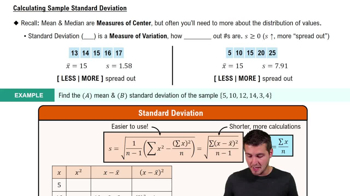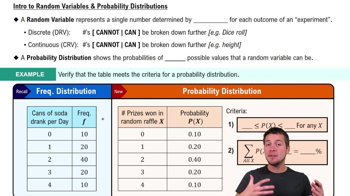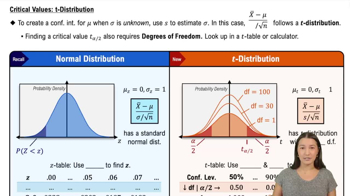Mint Specs Listed below are weights (grams) from a simple random sample of pennies produced after 1983 (from Data Set 40 “Coin Weights” in Appendix B). Construct a 95% confidence interval estimate of for the population of such pennies. What does the confidence interval suggest about the U.S. Mint specifications that now require a standard deviation of 0.0230 g for weights of pennies?
Table of contents
- 1. Intro to Stats and Collecting Data1h 14m
- 2. Describing Data with Tables and Graphs1h 55m
- 3. Describing Data Numerically2h 5m
- 4. Probability2h 16m
- 5. Binomial Distribution & Discrete Random Variables3h 6m
- 6. Normal Distribution and Continuous Random Variables2h 11m
- 7. Sampling Distributions & Confidence Intervals: Mean3h 23m
- Sampling Distribution of the Sample Mean and Central Limit Theorem19m
- Distribution of Sample Mean - Excel23m
- Introduction to Confidence Intervals15m
- Confidence Intervals for Population Mean1h 18m
- Determining the Minimum Sample Size Required12m
- Finding Probabilities and T Critical Values - Excel28m
- Confidence Intervals for Population Means - Excel25m
- 8. Sampling Distributions & Confidence Intervals: Proportion1h 12m
- 9. Hypothesis Testing for One Sample3h 29m
- 10. Hypothesis Testing for Two Samples4h 50m
- Two Proportions1h 13m
- Two Proportions Hypothesis Test - Excel28m
- Two Means - Unknown, Unequal Variance1h 3m
- Two Means - Unknown Variances Hypothesis Test - Excel12m
- Two Means - Unknown, Equal Variance15m
- Two Means - Unknown, Equal Variances Hypothesis Test - Excel9m
- Two Means - Known Variance12m
- Two Means - Sigma Known Hypothesis Test - Excel21m
- Two Means - Matched Pairs (Dependent Samples)42m
- Matched Pairs Hypothesis Test - Excel12m
- 11. Correlation1h 6m
- 12. Regression1h 50m
- 13. Chi-Square Tests & Goodness of Fit1h 57m
- 14. ANOVA1h 57m
7. Sampling Distributions & Confidence Intervals: Mean
Introduction to Confidence Intervals
Problem 10.2.14
Textbook Question
Regression and Predictions
Exercises 13–28 use the same data sets as Exercises 13–28 in Section 10-1.
Find the regression equation, letting the first variable be the predictor (x) variable.
Find the indicated predicted value by following the prediction procedure summarized in Figure 10-5.
Powerball Jackpots and Tickets Sold Listed below are the same data from Table 10-1 in the Chapter Problem, but an additional pair of values has been added from actual Powerball results. (Jackpot amounts are in millions of dollars, ticket sales are in millions.) Find the best predicted number of tickets sold when the jackpot was actually 345 million dollars. How does the result compare to the value of 55 million tickets that were actually sold?

 Verified step by step guidance
Verified step by step guidance1
Step 1: Organize the data into two variables: the predictor variable (x), which is the jackpot amounts, and the response variable (y), which is the number of tickets sold.
Step 2: Calculate the mean and standard deviation for both the x (jackpot amounts) and y (tickets sold) variables. These values are needed to compute the regression equation.
Step 3: Compute the correlation coefficient (r) using the formula: r = (Σ((x_i - x̄)(y_i - ȳ))) / (sqrt(Σ(x_i - x̄)^2) * sqrt(Σ(y_i - ȳ)^2)). This measures the strength and direction of the linear relationship between x and y.
Step 4: Use the formula for the slope (b) of the regression line: b = r * (s_y / s_x), where s_y and s_x are the standard deviations of y and x, respectively. Then calculate the y-intercept (a) using the formula: a = ȳ - b * x̄.
Step 5: Substitute the given jackpot value (345 million dollars) into the regression equation y = a + b * x to predict the number of tickets sold. Compare the predicted value to the actual value of 55 million tickets sold.
 Verified video answer for a similar problem:
Verified video answer for a similar problem:This video solution was recommended by our tutors as helpful for the problem above
Video duration:
6mPlay a video:
Was this helpful?
Key Concepts
Here are the essential concepts you must grasp in order to answer the question correctly.
Regression Equation
A regression equation is a mathematical representation that describes the relationship between a dependent variable and one or more independent variables. In this context, the jackpot amount serves as the independent variable (x), while the number of tickets sold is the dependent variable (y). The equation typically takes the form y = mx + b, where m is the slope and b is the y-intercept, allowing predictions of y based on given x values.
Recommended video:
Guided course

Calculating Standard Deviation
Predictor Variable
The predictor variable, also known as the independent variable, is the variable that is manipulated or controlled to observe its effect on another variable. In this scenario, the jackpot amount is the predictor variable, as it is used to predict the number of tickets sold. Understanding the role of the predictor variable is crucial for establishing the direction and strength of the relationship in regression analysis.
Recommended video:
Guided course

Intro to Random Variables & Probability Distributions
Predicted Value
A predicted value is the outcome generated by a regression equation when a specific value of the predictor variable is inputted. In this case, to find the predicted number of tickets sold when the jackpot is 345 million dollars, one would substitute this value into the regression equation. Comparing this predicted value to the actual number of tickets sold provides insights into the accuracy of the model and the relationship between the variables.
Recommended video:

Critical Values: t-Distribution

 6:33m
6:33mWatch next
Master Introduction to Confidence Intervals with a bite sized video explanation from Patrick
Start learningRelated Videos
Related Practice
Textbook Question
